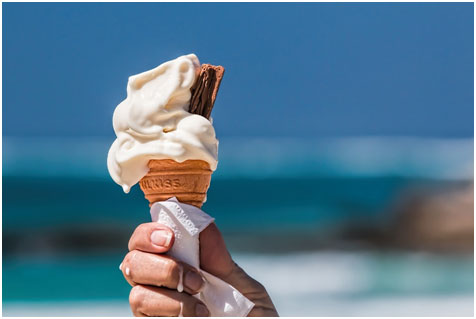Summary: Eating in moderation is the best option, but “healthier” brands like Halo Top do allow a bigger quantity to be eaten in one sitting.

Several companies have come out with pints of ice cream that are considered “healthier” than your average ice cream. One of the more well-known brands, Halo Top, describes its product as low calorie, high protein and low sugar, made with only the best ingredients. Halo Top sells 39 flavors in pint-sized containers, some of which are dairy-free and all of which range from 280 to 360 calories in the entire pint. This compares to most ice-cream servings, which are 120+ calories for a ½ cup.
Sounds pretty amazing, right? You can eat an entire pint worth of ice cream for the same amount of calories, plus it’s higher in protein and lower in sugar. But what’s the catch?
There are many different opinions on these new “healthy,” low-calorie ice cream pints that have hit the shelves in the past couple of years, so it’s important to hear all sides of the conversation. Some think they’re a great, healthier alternative to sugar-filled sweets, while others warn consumers about the negatives.
Nutritionally, these products contain many processed ingredients. For example, one of Halo Top’s simplest flavors, Vanilla Bean, contains “Skim milk, eggs, erythritol, prebiotic fiber, milk protein concentrate, cream, organic cane sugar, vegetable glycerin, natural flavor, sea salt, vanilla beans, organic carob gum, organic guar gum, organic stevia leaf extract.” Some of these ingredients are considered “indigestible,” which accounts for the low calorie count.
Some dieticians believe that one problem with eating these products, especially the entire pint, is that you’re getting a high volume of food but it is probably far less satisfying because of the low fat content, leaving you craving more. Although these products often use phrases surrounding getting in more protein and eating clean, it’s not as nutritious or as satisfying as eating less processed foods, such as fruits, vegetables or nuts, instead.
In addition to nutrition, there are mental considerations to be looked at as well. For one thing, when buyers think of the whole pint as an entire serving, their thought process can lead to overeating. Most Americans would rather eat a large serving of something low-calorie than a much smaller serving with the same amount of calories. Because there’s such a high focus on dieting in the U.S., many people feel deprived and want to eat more.
While some may be able to easily put the pint away once they feel full, even if they’ve only eaten half, others may not be able to. People struggling with eating disorders, especially binge eating disorder, may find themselves overeating these pints, thinking that it’s okay because it’s low-calorie even though it’s perpetuating binge eating behavior. This thinking leads them away from learning how to eat intuitively and instead satisfies their need to binge, which simply continues the cycle.
While there are many precautions to eating entire pints of “healthy ice cream,” it’s not actually harmful to your health unless you are prone to eating disorders or digestive issues. The key is to eat in moderation, just like everything else. Don’t create a habit of eating a pint every evening after dinner just because you can and instead consider them a treat when you’re craving something sweet.
